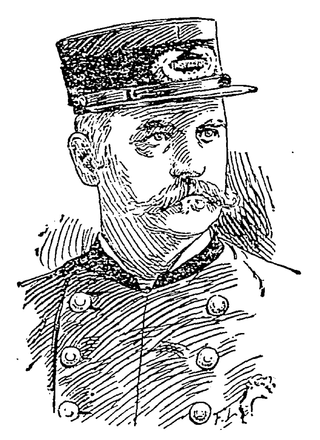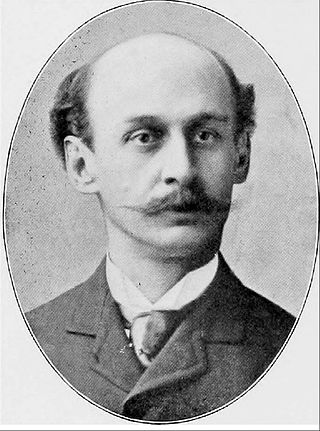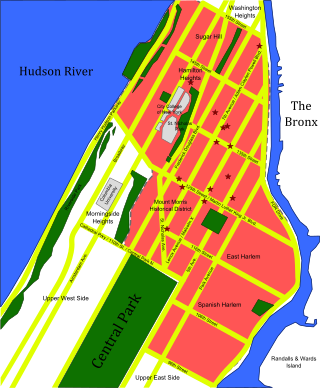
Broadway is a street and major thoroughfare in the U.S. state of New York. The street runs from Battery Place at Bowling Green in the south of Manhattan for 13 mi (20.9 km) through the borough, over the Broadway Bridge, and 2 mi (3.2 km) through the Bronx, exiting north from New York City to run an additional 18 mi (29.0 km) through the Westchester County municipalities of Yonkers, Hastings-On-Hudson, Dobbs Ferry, Irvington, Tarrytown, and Sleepy Hollow, after which the road continues, but is no longer called "Broadway". The latter portion of Broadway north of the George Washington Bridge/I-95 underpass comprises a portion of U.S. Route 9.

The Tenderloin was an entertainment and red-light district in the heart of the New York City borough of Manhattan during the late 19th and early 20th centuries.

Union Square is a historic intersection and surrounding neighborhood in Manhattan, New York City, United States, located where Broadway and the former Bowery Road – now Fourth Avenue – came together in the early 19th century. Its name denotes that "here was the union of the two principal thoroughfares of the island". The current Union Square Park is bounded by 14th Street on the south, 17th Street on the north, and Union Square West and Union Square East to the west and east respectively. 17th Street links together Broadway and Park Avenue South on the north end of the park, while Union Square East connects Park Avenue South to Fourth Avenue and the continuation of Broadway on the park's south side. The park is maintained by the New York City Department of Parks and Recreation.

Henry Janeway Hardenbergh was an American architect, best known for his hotels and apartment buildings, and as a "master of a new building form — the skyscraper." He worked three times with Edward Clark, the wealthy owner of the Singer Sewing Machine Company and real estate developer: The Singer company's first tower in New York City, the Dakota Apartments, and its precursor, the Van Corlear. He is best known for building apartment dwellings and luxury hotels.

Upper Manhattan is the northern section of the New York City borough of Manhattan. Its southern boundary has been variously defined, but some of the most common usages are 96th Street, 110th Street, 125th Street, or 155th Street. The term Uptown can refer to Upper Manhattan, but is often used more generally for neighborhoods above 59th Street; in the broader definition, Uptown encompasses Upper Manhattan.

New Brunswick Theological Seminary is a seminary of the Reformed Church in America (RCA), a mainline Protestant denomination in Canada and the United States that follows the theological tradition and Christian practice of John Calvin. It was founded in 1784 and is one of the oldest seminaries in the United States. First established in New York City under the leadership of John Henry Livingston, who instructed aspiring ministers in his home, in 1810 the seminary established its presence in New Brunswick, New Jersey, where its main campus is now located. Although a separate institution, the seminary's early development in New Brunswick was closely connected with that of Rutgers University before establishing its own campus in the city in 1856.

Tenth Avenue, known as Amsterdam Avenue between 59th Street and 193rd Street, is a north-south thoroughfare on the West Side of Manhattan in New York City. It carries uptown (northbound) traffic as far as West 110th Street, after which it continues as a two-way street.

Grace Church is a historic parish church in Manhattan, New York City which is part of the Episcopal Diocese of New York. The church is located at 800–804 Broadway, at the corner of East 10th Street, where Broadway bends to the south-southeast, bringing it in alignment with the avenues in Manhattan's grid. Grace Church School and the church houses—which are now used by the school—are located to the east at 86–98 Fourth Avenue between East 10th and 12th Streets. In 2021, it reported 1,038 members, average attendance of 212, and $1,034,712 in plate and pledge income.

The New York Theological Seminary (NYTS) was a private non-denominational Christian seminary in New York City. It was founded in 1900 as the Bible Teacher's College. It ceased operating as an independent seminary on July 1, 2024. Through a "long-term strategic partnership," it continues on as the “NYTS Institute for Urban Engagement” at Union Theological Seminary.

Daniel Fawcett Tiemann was Mayor of New York City from 1858 to 1860. He was a founding trustee of the Cooper Union for the Advancement of Science and Art.

Stuyvesant Square is the name of both a park and its surrounding neighborhood in the New York City borough of Manhattan. The park is located between 15th Street, 17th Street, Rutherford Place, and Nathan D. Perlman Place. Second Avenue divides the park into two halves, east and west, and each half is surrounded by the original cast-iron fence.

Robert Henderson Robertson was an American architect who designed numerous houses, institutional and commercial buildings, and churches. He is known for his wide-variety of works and commissions, ranging from private residences such as Jacqueline Kennedy's childhood home Hammersmith Farm and the Adirondacks Great Camp Santanoni, great civic buildings like Southport's Pequot Library for the Marquand Family to some of the earliest steel skyscrapers in New York City.

Claremont Avenue is a short avenue in the Morningside Heights neighborhood of Manhattan, New York City. It begins at 116th Street and runs north for a length of eleven blocks until it ends at Tiemann Place.

St. Ann’s Church was a Roman Catholic parish church at 110-120 East 12th Street between Fourth and Third Avenues in the East Village neighborhood of Manhattan, New York City. It was closed in 2003 and mostly demolished, except the front facade, in 2005. The site of the church is now occupied by a dorm of New York University.

Madison Square Presbyterian Church was a Presbyterian church in Manhattan, New York City, located on Madison Square Park at the southeast corner of East 24th Street and Madison Avenue. Construction on the church began in 1853 and was completed in 1854. It was designed by Richard M. Upjohn, the son of noted architect Richard Upjohn, in the Gothic Revival architectural style. The congregation's original building was acquired by the Metropolitan Life Insurance Company and was demolished in 1909 to make way for the 48-story Metropolitan Life Insurance Company Tower. In exchange, the church received a 75 feet (23 m) by 150 feet (46 m) plot of land across 24th Street that became the site for Stanford White's Madison Square Presbyterian Church.
West Presbyterian Church was a congregation and two houses of worship in Manhattan, New York City. The congregation was founded in 1829 and merged in 1911 with Park Presbyterian Church to form West-Park Presbyterian Church. The first house of worship, also known as the Carmine Street Presbyterian Church, in Greenwich Village, was used from 1832 to 1865, and the second, on West 42nd Street between Fifth Avenue and Sixth Avenue, from 1865 until 1911, when it was sold and demolished. Proceeds from the sale were used, in accordance with the merger agreement, to build and endow a church for an underserved neighborhood, Washington Heights: Fort Washington Presbyterian Church. In addition, the West Church congregation had earlier established two mission churches which eventually merged to become Good Shepherd-Faith Presbyterian Church. West-Park, Fort Washington, and Good Shepherd-Faith are all active today.

Burke Library of the Union Theological Seminary is located at 3041 Broadway, in the Morningside Heights neighborhood of Manhattan, New York City. Founded in 1838, since 2004 it has been a part of the Columbia University Libraries. Holding over 700,000 items, it is one of the largest theological libraries in North America.

The Church of Our Lady of Guadalupe and St. Bernard is a Roman Catholic parish church in the Roman Catholic Archdiocese of New York, located at 328-332 West 14th Street in the Greenwich Village neighborhood of Manhattan, New York City. It was established in 2003 as a result of a parish merger of the Manhattan parishes of Our Lady of Guadalupe and St. Bernard's Church.

The East 17th Street/Irving Place Historic District is a small historic district located primarily on East 17th Street between Union Square East and Irving Place in the Union Square neighborhood of Manhattan, New York City. It was designated by the New York City Landmarks Preservation Commission on June 30, 1988, and encompasses nine mid-19th century rowhouses and apartment buildings on the south side of East 17th Street, from number 104 to number 122, plus one additional building at 47 Irving Place just south of 17th Street.


















